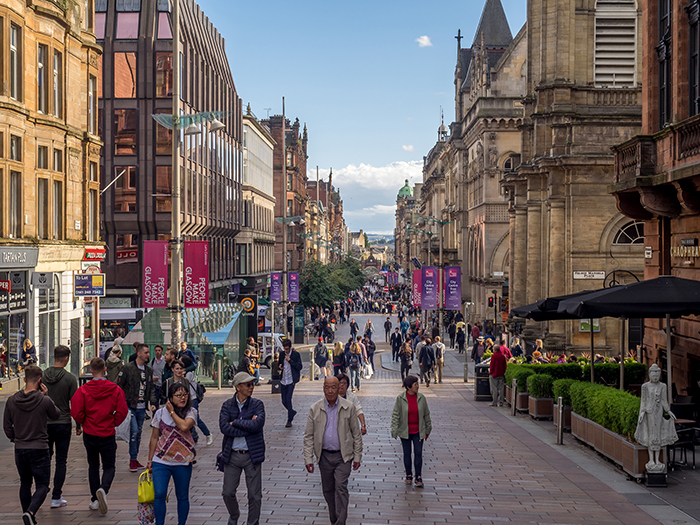
GLASGOW City Council will publish an independent just transition skills blueprint for the construction sector as part of approved plans to revamp the city centre and beyond, Project Scotland has been told.
Speaking at the announcement of plans to transform the city’s Golden Z (Argyle, Buchanan, and Sauchiehall Streets), Susan Aitken, leader of the council, told us that the document will focus on opportunities to create buildings that are fit for the future – whether that be retrofitting existing ones or new developments – as part of the local authority’s net zero journey.
“The whole skills side of things is enormously important to us,” she explained. “We want to do what we can as a public sector to support the industry to be in the right place to help us deliver our aspirations.”
The council has lofty aspirations for the Golden Z, with Stantec, Threesixty Architecture, and Kevin Murray Associates brought on board to develop the plan, with work set to start next year and conclude in 2030. The plan will look to double the area’s population to 40,000 through the build of new developments and repurposing of existing buildings, with a particular focus on turning upper floors into residential and flexible work spaces and rooftops into bars and restaurants. A school and/or primary care centre is also proposed to support the growth in population.
Improved active travel routes are planned, as well as the creation of new urban parks with the site of the former Victoria’s nightclub on Sauchiehall Street earmarked, as well as sites at Trongate and by St Enoch Square.

The overall plans would see a move away from a reliance on retail and a focus on residential, leisure, and culture.
During the unveiling of the plans, Manchester was cited as a city that has undergone a successful transformation of its centre. In the last financial year, the north west of England overtook London as having the most house build starts.
Leader of the Scottish Labour Party, Anas Sarwar, recently said Glasgow should look at the lessons from Manchester. Asked if she agreed, councillor Aitken told Project Scotland that ‘there is some truth in that’ and that Glasgow has ‘a lot of catching up to do’ with Manchester. However, she noted that Manchester City Council has worked ‘very strongly’ with the private sector over the last 20 to 30 years to bring such development to fruition, something she said hasn’t always happened in Glasgow.
“What I would say is there is another side to that,” she added. “The very, very fast development that Manchester city centre has had has also been development that’s priced a lot of people out of Manchester city centre; ordinary Mancunians are not able to afford to live in a lot of these new developments. We don’t want to repeat that, so there are some things that Manchester has done that we can learn from to not repeat and to make sure that we can do better, but there are other things such as the collaborative partnerships that Manchester built over many decades, which Glasgow is catching up with now; absolutely we can learn from that.”

Plans for the build of 1,500 build-to-rent homes in the High Street area of Glasgow city centre were recently paused due to developer concerns over the Scottish Government’s rent control policy.
“I’m not going to say that a development going ahead is more important than making sure people are able to pay their rent during this cost-of-living crisis,” councillor Aitken stated, before adding that she sees BTR as an ‘important part’ of the mix of accommodation types.
“What I would say is that national government – the Scottish Government in this case – probably does need to have an exit strategy. If rent controls are to be part of Scotland’s future, then how do we make sure that we’ve got a policy that balances the quite right, quite correct national imperative to support people through a cost-of-living crisis and support people who are potentially facing crisis at any time with our local and national desires to continue to boost economic development and housebuilding?”

With skyscrapers becoming a more regular fixture in many major UK cities, Glasgow City Council is currently developing a tall buildings strategy.
“I think there is definitely a place for tall buildings,” councillor Aitken revealed, after being asked if they have a place in Glasgow given its past with high-rises. “Urban density we know is one of the tools we have for fighting the climate emergency; it is a climate-friendly way to live, if it’s done well and it’s done properly – but we want to have clarity around a clear vision for that. Where do tall buildings fit? Where do we want them? And how do we want them to interact with their surroundings?
“I know sometimes there’s a bit of a knee-jerk reaction of, ‘Oh, we don’t like skyscrapers’, but actually done well they can really contribute. We’re working on a clear policy on how we manage density and do it right, so that we’re not looking back in 10 years’ time and thinking, ‘Oh God, we should never have built that’.”
In terms of the Golden Z plans, councillor Aitken said confidence should be taken from the transformation of other areas of the city including the east end, Gorbals, and Sighthill.
“Really, all over the city there has been some quite spectacular regeneration,” she continued. “Glasgow has done something spectacular, and it frustrates me that there is sometimes a focus on the city centre sometimes to the exclusion of everything else.
“I said today that Glasgow city centre is the single most important economic space in Scotland. It is… but Glasgow’s neighbourhoods are where most of our people live, where they spend their lives, bring up their families, and the quality of those neighbourhoods and the investment in those neighbourhoods (means) Glasgow has an incredible story to tell; the UN points to our model, the community-led housing model across the city; it has been absolutely transformative.

“There are a lot of cities where maybe you go to the city centre and it might look good, but then you go beyond the city centre not so much, and there’s a lot that they can learn from Glasgow on how to make sure neighbourhoods are also being transformed as well as the places where commerce happens.”
Councillor Angus Millar, convener for city centre recovery at Glasgow City Council, commented, “As part of our wider efforts to guide city centre recovery and support investment in Glasgow, the Vision and Delivery Plan for the Golden Z looks in depth at this key part of Glasgow city centre to help ensure it thrives in future as it adapts to face challenges and take the opportunities coming its way.
“The recommendations and actions within the plan for the Golden Z aim to ensure that buildings, sites and spaces in the area are all fully used to contribute to its attractiveness as a place for everyone who uses it to live, work, visit and invest in. We look forward to working with everyone with a stake in the Golden Z to deliver these aims in making the area is all it can and should be.”








